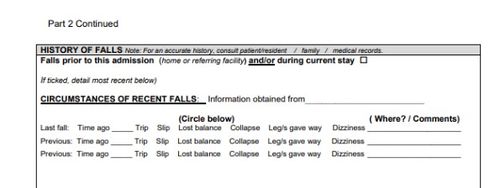8 Simple Techniques For Dementia Fall Risk
See This Report about Dementia Fall Risk
Table of ContentsHow Dementia Fall Risk can Save You Time, Stress, and Money.The Ultimate Guide To Dementia Fall RiskThe Best Guide To Dementia Fall RiskFacts About Dementia Fall Risk UncoveredWhat Does Dementia Fall Risk Mean?
Make sure that there is an assigned area in your medical charting system where staff can document/reference ratings and document relevant notes related to fall prevention. The Johns Hopkins Autumn Threat Assessment Tool is one of lots of tools your staff can utilize to aid protect against damaging clinical events.Person drops in medical facilities prevail and debilitating damaging events that continue in spite of years of effort to minimize them. Improving interaction throughout the examining registered nurse, care group, person, and client's most included good friends and family might enhance autumn avoidance efforts. A team at Brigham and Women's Hospital in Boston, Massachusetts, looked for to create a standardized fall prevention program that centered around boosted communication and patient and household interaction.

The innovation group highlighted that successful execution relies on client and staff buy-in, integration of the program right into existing process, and fidelity to program processes. The team kept in mind that they are coming to grips with just how to make certain connection in program application during periods of crisis. During the COVID-19 pandemic, as an example, a rise in inpatient falls was connected with restrictions in individual involvement together with constraints on visitation.
The Dementia Fall Risk Ideas
These incidents are normally thought about preventable. To carry out the treatment, companies require the following: Accessibility to Autumn ideas sources Autumn suggestions training and re-training for nursing and non-nursing team, including new nurses Nursing workflows that permit person and household involvement to perform the falls analysis, make sure usage of the prevention strategy, and perform patient-level audits.
The outcomes can be very harmful, usually speeding up patient decrease and creating longer healthcare facility stays. One study estimated stays raised an additional 12 in-patient days after a patient autumn. The Autumn TIPS Program is based on engaging patients and their family/loved ones throughout 3 major procedures: assessment, personalized preventative interventions, and bookkeeping to make sure that patients are engaged in the three-step fall prevention procedure.
The individual assessment is based on the Morse Fall Scale, which is a confirmed fall threat analysis tool for in-patient healthcare facility settings. The scale includes the 6 most typical factors patients in medical facilities drop: the individual autumn history, high-risk conditions (including polypharmacy), use of IVs and various other exterior devices, mental status, stride, and movement.
Each danger aspect web links with one or more actionable evidence-based treatments. The nurse develops a strategy that integrates the interventions and is visible to the care group, client, and family on a laminated poster or printed aesthetic help. Nurses establish the strategy while meeting the client and the person's family.
The 25-Second Trick For Dementia Fall Risk
The poster functions as a communication tool with various other members of the client's care team. Dementia Fall Risk. The audit element of the program consists of assessing the client's expertise of their threat elements and prevention plan at the system top article and hospital levels. Nurse champions conduct at the very least 5 private interviews a month with clients and their households to examine for understanding of the loss avoidance strategy

A projected 30% of these drops outcome in injuries, which can range in severity. Unlike various other negative events that require a standardized clinical response, loss prevention depends highly on the needs of the individual.
The Single Strategy To Use For Dementia Fall Risk

Based on auditing results, one site had 86% compliance and two websites had more than 95% compliance. A cost-benefit evaluation of the Fall ideas program in eight healthcare facilities approximated that the program cost $0.88 per individual to implement and led to savings of learn this here now $8,500 per 1000 patient-days in direct prices related to the prevention of 567 drops over three years and eight months.
According to the innovation team, companies interested in carrying out the program should perform a readiness analysis and falls avoidance gaps evaluation. 8 Additionally, companies should make sure the necessary facilities and operations for implementation and establish an implementation strategy. If one exists, the organization's Loss Prevention Task Pressure ought to be associated with preparation.
Dementia Fall Risk - An Overview
To start, companies should make certain completion of training components by registered nurses and nursing aides - Dementia Fall Risk. Healthcare facility staff must evaluate, based on the requirements of a medical facility, whether to utilize an electronic wellness document printout or paper version of the autumn avoidance strategy. Carrying out groups ought to recruit and train nurse champs and establish processes for bookkeeping and reporting on fall information
Personnel need to be involved in the procedure of revamping the workflow to involve individuals and family in the analysis and avoidance plan process. Solution should be in area to make sure that systems can understand why a loss occurred and remediate the reason. Much more especially, nurses should have networks to provide recurring comments to both team and system leadership so they can readjust and boost autumn avoidance operations and connect systemic problems.